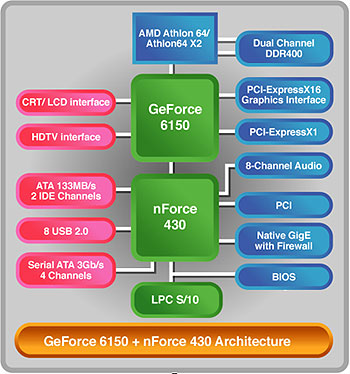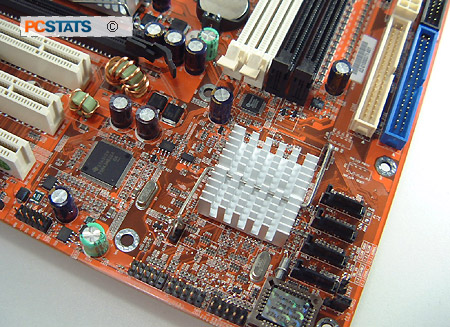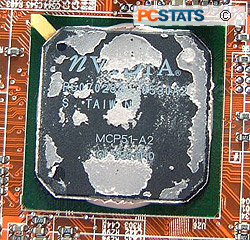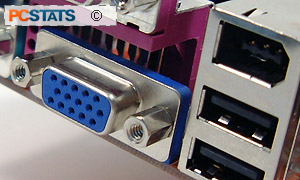The nVidia GeForce 6100 and 6150-series chipsets give AMD users something
they have very badly needed, a low cost fully integrated solution. The GeForce 6100-series
GPUs are built on TSMC's 90 nanometer manufacturing process, and are intended to support current
Socket 939 AMD Athlon64 processors. Memory support is actually up to the memory
controller built into the Athlon64 processor, but from what we have seen so far
most GeForce 6100 series motherboards will have four DDR DIMM slots,
which means up to 4GB of PC3200 DDR RAM can be used. The GeForce 6100-series
chipset is connected to the Athlon64 processor via a 1 GHz 16/16 Up/Down Hypertransport
connection (which is adjustable in the BIOS).

There
are two different versions of the GeForce 6100-series; the 6150 and the 6100.
The GeForce 6150 as its name indicates, supports slightly more features such as a TV encoder,
TMDS/DVI support, a slightly higher graphics core speed (475 MHz as opposed to 425
MHz for the 6100), 18 total PCI Express lanes (16 for the videocard, two
for misc devices), 1080p/1080i HD playback and higher video scaling.
The GeForce 6100 on the other hand does not support TV encoding
or TMDS/DVI output, and only sports standard definition (4:3) playback.
|
NVIDIA GeForce 6150 and NVIDIA nForce
430 |
NVIDIA GeForce 6100 and NVIDIA nForce
430 |
NVIDIA GeForce 6100 and NVIDIA nForce
410 |
| TV Encoder |
Yes |
No |
No |
| TMDS/DVI |
Yes |
No |
No |
| Graphics Clock |
475 MHz |
425 MHz |
425 MHz |
| PCI-Express |
1x16
2x1 |
1x16
1x1 |
1x16
1x1 |
| MPEG-2/WMV9 Playback |
high-definition (1080p/1080i) |
standard definition |
standard definition |
| Audio |
HDA (Azalia)/AC97 |
HDA (Azalia)/AC97 |
HDA (Azalia)/AC97 |
| SATA/PATA drives |
4/4 |
4/4 |
2/4 |
| RAID |
0,1,0+1,5 |
0,1,0+1,5 |
0,1 |
| Ethernet |
10/100/1000 |
10/100/1000 |
10/100 |
The nVidia GeForce 6100 series is not a single chipset solution, and so it is
combined with the nforce 430 or 410 Southbridge. Both Southbridge chipsets are
Serial ATA II compatible, however the nForce 410 supports RAID modes 0, 1, 0+1
and 5 while the nForce 400 only supports modes 0 and 1.
Both Southbridge chipsets have support for four Serial ATA devices as well as
four IDE. Although, when the nForce 400 is used in conjunction with the GeForce
6100 Northbridge, only two Serial ATA channels are available.

The nVidia nForce 410 supports Gigabit LAN as well as nVIDIA's hardware
ActiveArmor Firewall, while the 400 series Southbridge only has an integrated
10/100 MAC and no protection.
 The nForce 400 series chipsets are also compatible
with Intel's new Azalia 7.1 channel high definition audio codec. Connecting the
motherboard chipsets is another HyperTransport connection; this however only
runs at 800 MHz with an 8 bit wide Up/Down data bus.
The nForce 400 series chipsets are also compatible
with Intel's new Azalia 7.1 channel high definition audio codec. Connecting the
motherboard chipsets is another HyperTransport connection; this however only
runs at 800 MHz with an 8 bit wide Up/Down data bus.
Component output (Y, Pb, Pr) support is vendor specific,
some manufacturers like Asus are leaving component output for header brackets, others
like Gigabyte and its GA-K8N51PVMT-9 sport Component output natively on the rear I/O.
This Foxconn motherboard does not  include Component outputs.
include Component outputs.
The GeForce 6100 series graphics cards has two pixel rendering pipelines so
that right away should tell users the onboard graphics card is best only for
casual gaming. It does however support the DirectX 9.0C standard as well as
support for Shader Model 3.0, so the onboard videocard will work just fine with
Microsoft's Vista upcoming 3D desktop.
Both DVI and analog monitors are supported, but once again it is up
to the motherboard manufacturer to decide which it implements. Another nice feature
is that the onboard graphics card is not automatically disabled when using
a PCI Express x16 graphics card. Users who need a lot of desktop screen real
estate will certainly appreciate that feature.
nVIDIA
PureVideo
High definition is the future entertainment standard of tomorrow's video's. Playing high definition content on current generation PCs can boggle down even the fastest processors because there is more data to handle. Similar to the need for DVD accelerators a few years ago, nVIDIA PureVideo enables computer users to view MPEG-2/DVD and WMV HD formats without slowing the PC to a crawl.
The PureVideo standard incorporates a hardware accelerator for the afore mentioned MPEG-2/DVD, and Microsoft Windows Media HD Video standards (WMV HD). According to nVIDIA's documentation on PureVideo, the GPU (GeForce 6 and 7 series GPUs) takes on video decoding tasks from the CPU, and the end result is smoother, shutter free HD playback. nVIDIA PureVideo also supports most current and future high definition formats. The system seems to be built with a good degree of future proofing for upcoming standards.
PureVideo is more than just a media accelerator; it also includes features to improve video picture quality. If you believe the marketing; DVD, cable and satellite video provide poor crispness, clearness and smoothness that consumers have been desperate to be "saved from." nVIDIA's PureVideo technology applies spatial temporal de-interlacing to apparently deliver a better image than traditional de-interlacing can muster. PureVideo also fixes the 3:2 pull down problem that can arise from 24 fps video being converted to 30 fps for viewing on TVs or monitors. By recovering the original 24 frame content, PureVideo apparently allows for a clear crisper image.
Another neat feature of PureVideo is its ability to scale videos to any resolution, while maintaining a relatively detailed picture. This means users can view lower resolution videos at a high resolution without suffering too much from blocky or blurry pictures.
Overclocking the little Foxconn
motherboard!
 |
| Overclocking Results: |
|
|
Before starting to overclock, the CPU clock multiplier was lowered to 6x and
memory frequency set to run at 166 MHz mode. This way neither the processor nor
memory would limit the WinFast 6150K8MA-8EKRS motherboard. HyperTransport speeds will be
adjusted when needed.
Starting at 200 MHz the Winfast 6150K8MA-8EKRS's
clock speed was increased in 5 MHz intervals. The motherboard was actually quite
a pleasure to overclock. At 225 MHz, it started to show some
signs of instability, failing to POST or locking up while loading Windows.
Lowering the HTT multiplier from 5x to 4x solved that issue, and some further
overclocking was possible.
The Foxconn WinFast 6150K8MA-8EKRS would not go much
higher than 225MHz, and in the end
we settled for
a maximum overclocked speed of 232 MHz. Anything higher and the board would
fail Prime95 within 10 minutes. Next up a quick look at the BIOS before moving right
into the benchmarks!
